We came to Central Minnesota to visit my husband's family — and to enjoy some fall color.
Our fall color in central California is mainly provided by the radiant yellow of the big leaf maples, which are not yet putting on their display down our nearby creekside road. Maybe this is not the year for them.
But in Minnestoa, sugar maples and red oaks and other trees light up the woodlands in late September and early October.
I also enjoyed seeing some late blooming wild native plants. These Symphyotrichum laeve (Smooth Blue Aster) reminded me of our own California asters:
(I IDed the plants at Minnesota Wildflowers).
and these were everywhere too - Symphyotrichum laeve (Smooth Blue Aster) (Black-eyed Susan).
I'm not sure what this next one was - it was at my brother-in-law's lake house:
Most interestingly, my brother-in-law's wife told me about the lakeside native plant project she is undertaking, with rebates and oversight from the local government (via a landscape company I believe). The idea is to absorb runoff into the lake and prevent pollution. Fertilizing lawns, of course, is also discouraged. And these days you can't build a house closer than 100 yards from the lake shore.
I only caught a few names - one section of the area has labels:
In addition to the Carex deweyana, Dewey's sedge, I saw labels for Helianthus hirsutus, hispid sunflower and Viola cucullata, Marsh Blue Violet.
The mulch was interesting - sort of a chopped-straw mixture. As agriculture predominates in the region I suppose it's a plentiful ingredient. I think it was called environmental mulch perhaps.
Some lakes are specified as "environmental" which means, among other things, no power boats etc. The lake where we stayed was not one of those, but it was pretty quiet most of the time. People fished for sunnys, crappies, walleye and more.
Opposite their property, the view is wonderful:
In Minnesota - land o' lakes - there are about 15000 lakes. They formed during and after the ice age that dragged huge glaciers across the continent. Chunks of glacier ice were left behind, buried in the ground. They melted and — voila!













Comments